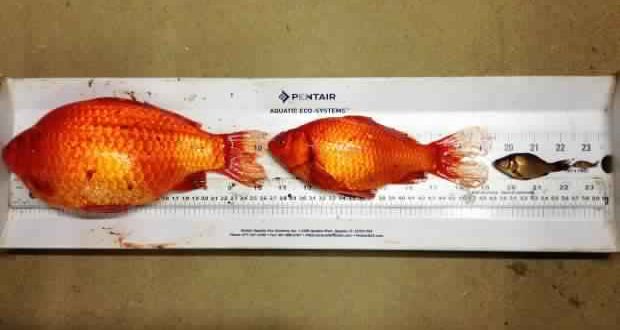Hundreds of wild goldfish, which measure up to 25 centimetres long, have overrun two storm water ponds in Okotoks.
Officials worry they could spill over into the Sheep and Bow rivers and their tributaries, where they could out-eat and out-live native fish while spreading disease among plants.
“They have no natural predators, and they can grow really large and get out into the natural ecosystem and cause all sorts of problems,” said Bridget Couban, landscape inspector with Okotoks’s parks department.
The Guinness Book of World Records documented an 18.7-inch-long goldfish belonging to a Dutch man named Joris Gjisbers. Another gargantuan goldfish named Goldie made headlines in Britain. Goldie’s owner, an 83-year-old widow, said she bought the fish at a pet store when he was just an inch long. In 2008, Goldie was 15.7 inches long and weighed more than two pounds.
In January, fisherman Mike Martin pulled a 15-inch goldfish out of the waters of Lake St. Clair near Detroit.
The fancier name for the common domesticated goldfish is Carassius auratus. This fish is a member of the carp family and is native to China. That family resemblance between the carp and the goldfish means that sometimes people mistake the former for the latter – as seen when one French fisherman caught a 30-pound carp that some newspapers mistook for a goldfish.
While your goldfish is very unlikely to reach 30 pounds, it does seem that there’s some truth to the truism that goldfish can grow to fit their environment.
Wild goldfish are quite versatile, able to live in rivers, streams, ditches, lakes, and ponds and tolerate a broad range of temperatures. While most wild goldfish are a drab gray in color, red-gold colors do occur naturally, and have been propagated through breeding and housing techniques.
Agencies/Canadajournal
 Canada Journal – News of the World Articles and videos to bring you the biggest Canadian news stories from across the country every day
Canada Journal – News of the World Articles and videos to bring you the biggest Canadian news stories from across the country every day



